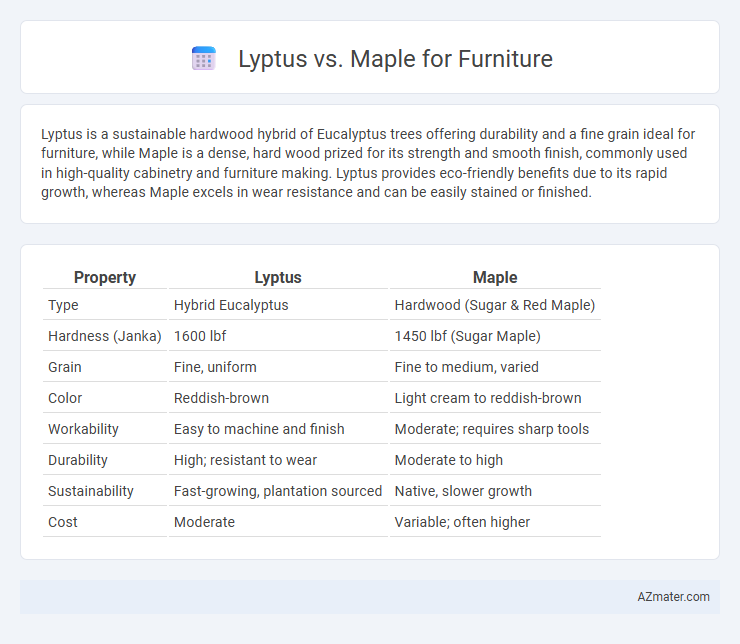Lyptus is a sustainable hardwood hybrid of Eucalyptus trees offering durability and a fine grain ideal for furniture, while Maple is a dense, hard wood prized for its strength and smooth finish, commonly used in high-quality cabinetry and furniture making. Lyptus provides eco-friendly benefits due to its rapid growth, whereas Maple excels in wear resistance and can be easily stained or finished.
Table of Comparison
| Property | Lyptus | Maple |
|---|---|---|
| Type | Hybrid Eucalyptus | Hardwood (Sugar & Red Maple) |
| Hardness (Janka) | 1600 lbf | 1450 lbf (Sugar Maple) |
| Grain | Fine, uniform | Fine to medium, varied |
| Color | Reddish-brown | Light cream to reddish-brown |
| Workability | Easy to machine and finish | Moderate; requires sharp tools |
| Durability | High; resistant to wear | Moderate to high |
| Sustainability | Fast-growing, plantation sourced | Native, slower growth |
| Cost | Moderate | Variable; often higher |
Introduction to Lyptus and Maple
Lyptus is a fast-growing hybrid eucalyptus known for its durability, hardness, and sustainable forestry practices, making it an eco-friendly choice for furniture production. Maple, a hardwood species native to North America, is prized for its fine grain, strength, and versatility in crafting furniture with a smooth finish. Both woods offer unique qualities, with Lyptus excelling in sustainability and hardness, while Maple provides a classic look and excellent workability.
Botanical Origins and Growth Regions
Lyptus, a hybrid eucalyptus species primarily grown in fast-growing plantations in Brazil, is prized for its eco-friendly harvesting and rapid growth cycle. Maple, sourced from various Acer species native to North America and parts of Europe and Asia, thrives in temperate forests with slower growth rates, resulting in denser, harder wood. The distinct botanical origins and regional growth conditions influence the grain patterns, durability, and sustainability profiles of Lyptus and Maple furniture.
Appearance and Grain Patterns
Lyptus wood features a uniform, medium reddish-brown color with a smooth, consistent grain pattern that offers a modern and clean aesthetic for furniture. Maple wood, especially hard maple, showcases a lighter cream to pale brown hue with distinctive swirling, curly, or birdseye grain patterns that add character and visual interest. The subtle grain of Lyptus creates a sleek look, while maple's pronounced patterns provide a more traditional and textured appearance.
Hardness and Durability
Lyptus wood, a hybrid of eucalyptus species, offers a Janka hardness rating of around 1,200, making it notably harder and more resistant to dents than maple, which typically ranges between 950 and 1,200 depending on the variety. Both woods deliver solid durability for furniture, but Lyptus's tight grain and dense structure enhance its resistance to wear and potential damage over time. Maple's smooth texture and consistent grain make it easier to finish, yet Lyptus provides superior toughness for high-traffic furniture applications.
Workability and Machining Properties
Lyptus exhibits excellent workability with its uniform grain and smooth texture, making it easy to cut and shape using standard woodworking tools. Its stable machining properties minimize tool wear and allow for precise detailing, ideal for furniture requiring intricate designs. Maple, known for its hardness and density, offers superior durability but can be tougher on tools, requiring sharper blades and slower feed rates to achieve clean cuts and smooth finishes.
Environmental Impact and Sustainability
Lyptus wood, sourced from fast-growing Eucalyptus trees, offers a more sustainable option due to its rapid regrowth and certification by the Forest Stewardship Council (FSC), ensuring responsible forest management practices. Maple, being a slower-growing hardwood native to North America, typically requires more time to replenish, which can lead to higher environmental impacts if not sourced from sustainably managed forests. Choosing Lyptus over maple for furniture production can minimize deforestation rates and reduce carbon footprints through its quicker harvest cycles and commitment to sustainable cultivation.
Cost Comparison
Lyptus wood generally costs less than maple due to its faster growth and sustainable harvesting practices, making it an economical choice for furniture production. While maple offers superior hardness and a more uniform grain, its higher price reflects slower growth rates and limited availability. Choosing Lyptus can reduce material expenses without significantly compromising durability or aesthetic appeal in furniture applications.
Finishing and Maintenance
Lyptus offers a smooth, closed-grain surface that responds well to various finishes, creating a durable and attractive exterior for furniture. Maple, known for its fine, consistent grain, takes stain and lacquer evenly, allowing for a wide range of finishing options. Maintenance-wise, Lyptus is resistant to dents and scratches, requiring minimal upkeep, while Maple needs periodic sealing and careful handling to maintain its appearance over time.
Best Applications in Furniture Making
Lyptus offers excellent durability and resistance to wear, making it ideal for high-traffic furniture pieces such as desks, tables, and cabinetry that require long-lasting performance. Maple's fine, uniform grain and smooth texture suit detailed woodwork like drawer fronts, chairs, and decorative accents where precision and aesthetics are paramount. Both woods excel in furniture making, with Lyptus favored for strength and Maple preferred for its classic beauty and versatility in intricate designs.
Choosing Between Lyptus and Maple
Choosing between Lyptus and Maple for furniture depends on durability, grain pattern, and sustainability. Lyptus offers a harder, more environmentally friendly alternative grown in managed plantations with a uniform reddish hue, while Maple provides a classic light color with fine, consistent grain and excellent shock resistance. Consider the aesthetic preference and environmental impact when selecting the optimal hardwood for furniture projects.

Infographic: Lyptus vs Maple for Furniture
 azmater.com
azmater.com